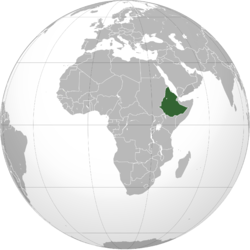Derg
| Provisional Military Government of Socialist Ethiopia | ||||||||||
| የኅብረተሰብአዊት ኢትዮጵያ ጊዜያዊ ወታደራዊ መንግሥት ye-Hebratasabʼāwit Ītyōṗṗyā Gizéyāwi Watādarāwi Mangeśt |
||||||||||
|
||||||||||
|
||||||||||
|
Anthem Ītyoṗya, Ītyoṗya, Ītyoṗya, qidä mī ኢትዮጵያ, ኢትዮጵያ, ኢትዮጵያ ቅደሚ Ethiopia, Ethiopia, Ethiopia be first |
||||||||||
| Capital | Addis Ababa | |||||||||
| Languages | Amharic | |||||||||
| Government | Marxist–Leninist military junta | |||||||||
| Chairman | ||||||||||
| • | 1974 | Aman Michael Andom | ||||||||
| • | 1974–1977 | Tafari Benti | ||||||||
| • | 1977–1987 | Mengistu Haile Mariam | ||||||||
| Legislature | Shengo | |||||||||
| Historical era | Cold War | |||||||||
| • | Coup d'état | 12 September 1974 | ||||||||
| • | Monarchy abolished | 21 March 1975 | ||||||||
| • | Constitution adopted | 22 February 1987 | ||||||||
| Area | ||||||||||
| • | 1987 | 1,221,900 km² (471,778 sq mi) | ||||||||
| Population | ||||||||||
| • | 1987 est. | 46,706,229 | ||||||||
| Density | 38.2 /km² (99 /sq mi) | |||||||||
| Currency | Ethiopian birr (ETB) | |||||||||
| Calling code | +251 | |||||||||
|
||||||||||
| Today part of |
|
|||||||||
The Derg, Common Derg or Dergue (Ge'ez: ደርግ, meaning "committee" or "council") is the short name of the Coordinating Committee of the Armed Forces, Police, and Territorial Army that ruled Ethiopia from 1974 to 1987. It took power following the ousting of Emperor Haile Selassie I. Soon after it was established, the committee was formally renamed the Provisional Military Administrative Council, but continued to be known popularly as "the Derg". In 1975, it formally abolished the monarchy and embraced Communism as an ideology. Its regime eventually became formally known as the Provisional Military Government of Socialist Ethiopia. Between 1975 and 1987, the Derg executed and imprisoned tens of thousands of its opponents without trial. In 1987 Mengistu Haile Mariam, its chairman since 1977, abolished the Derg and replaced it with the People's Democratic Republic of Ethiopia. However, Mengistu and the surviving members of the Derg dominated the new government. After years of warfare by a coalition of ethnic-based parties, Mengistu was overthrown in 1991.
The Coordinating Committee of the Armed Forces, Police, and Territorial Army, or the Derg (Ge'ez "Committee"), was officially announced 28 June 1974 by a group of military officers. This was done in order to maintain law and order, due to the powerlessness of the civilian government following widespread mutiny in the armed forces of Ethiopia earlier that year. Its members were not directly involved in those mutinies (as far as anyone knows), nor was this the first military committee organized to support the administration of Prime Minister Endelkachew Makonnen. Alem Zewde Tessema had established the Armed Forces Coordinated Committee 23 March. Over the following months, radicals in the Ethiopian military came to believe Makonnen was acting on behalf of the hated feudal aristocracy. When a group of notables petitioned for the release of a number of government ministers and officials who were under arrest for corruption and other crimes, three days later the Derg was announced.
The Derg, which originally consisted of soldiers at the capital, broadened its membership by including representatives from the 40 units of the Ethiopian Army, Air Force, Navy, Kebur Zabagna (Imperial Guard), Territorial Army and Police: each unit was expected to send three representatives, who were supposed to be privates, NCOs and junior officers up to the rank of major. According to Bahru Zewde, "Senior officers were deemed too compromised by close association to the regime." It is often said that the Derg consisted of 120 soldiers, a statement which has gained wide acceptance due to the habitual secretiveness of the Derg in its early years. But, Bahru Zewde notes that "in actual fact, their number was less than 110", and Aregawi Berhe mentions two different sources which record 109 persons as being members of the Derg. No new members were ever admitted, and the number decreased, especially in the first few years, as some members were expelled or killed.
...
Wikipedia



